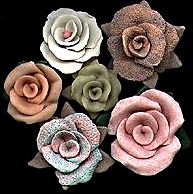|
|

 |
A rose is one of the most beautiful flowers you can make from clay, and also one of the easiest, since you can make a realistic rose with a single color of clay. Optionally, you can add a calyx - the green outer whorl that covers the base of the rose where it joins the stem.
The seven petaled rose technique is suitable for roses from about 1/2 inch to about 2 inches across. For a smaller rose, try making a bud using just the first four petals; for a larger rose, add three or four additional petals around the outside.
You can use any polymer clay brand for this project. Since the rose petals are thin at the edges, strength of the clay is a factor; if your roses will be banged around a lot - for example, if you're going to make a dangling pendant out of them - it would be wise to choose one of the stronger clays.
Color is up to you. You can obtain very realistic rose colors by using a mixture of half translucent with half your color. Some good base colors include orange Granitex, white bordeaux Fimo, rose quartz stone Fimo, and flesh Sculpey (add a little fluorescent orange to brighten it). For the calyx (if you want to make one), use leaf green, or make your own mix of gray and green.
|
![[The starting ball of clay]](rose-images/clayball.jpg)
Step 1: Dividing the Clay
After conditioning and mixing your clay as usual, make a ball, depending on the size you want the finished rose to be. Divide the ball into seven pieces. The pieces should be about the same size, but they don't need to be exactly divided. Each piece will become one petal of your rose.
![[A flat rose petal]](rose-images/new-petal.jpg)
Step 2: Making a Rose Petal
Roll the smallest of the seven pieces between your palms to smooth it, then press it to make a flat petal in a rounded triangle shape (roughly the shape of a guitar pick). The point (which will become the base of the rose) should be thicker than the opposite edge, which will be the top of the petal; this top edge will be about 1/16th of an inch thick.
![[The rosebud]](rose-images/folded-bud.jpg)
Step 3: Folding the Petal Into a Bud
Hold the petal with the thick point down and use the other hand to gently fold the sides in on themselves, forming a rosebud. The edges should overlap a little.
![[The second petal]](rose-images/petal-2.jpg)
Step 4: Wrapping the Second Petal
Use the next clay piece to form another petal a little bigger than the first, with the top edge slightly thinner. Hold the bud by the bottom in one hand and use the other to wrap the petal around it. The petal's top edge should protrude a little above the top of the bud.
![[The third petal]](rose-images/petal-3.jpg)
Step 5: Forming and Attaching the Third and Fourth Petals
Form a third petal, again a little bigger than the second. Wrap it around the first two petals, offsetting it so the three petals form a spiral when you look at the rose from above. Gently roll just the edge of the petal outward, using the tip of your finger. Then form and attach the fourth petal in the same way.
Each petal should be a little thinner at the edge than the one before, and each one should stick up a little above the previous petals.
![[The outer petals]](rose-images/petal-5.jpg)
Step 6: Making the Remaining Petals
Form and attach the outer three petals. The edges should be paper-thin; gently roll the top of the edge back after attaching each petal. For a wider, more "blown" flower, curl the whole petal back; for a more budlike look, curl just the very edge.
When all the petals are attached, squeeze the base of the rose gently to meld the petals together. Hold the rose gently and use a knife or needle to cut off most of the base, making a flat bottom for the rose. (If you're going to add a calyx, the bottom doesn't need to be completely flat.)
![[The finished rose]](rose-images/finished-rose.jpg)
Step 7: Firing the Finished Rose
Fire the rose using the temperature and time you normally use. (If you're using translucent clay or a mix of translucent with light colors, remember that it requires a lower temperature and may darken at high firing temperatures.) If you are going to attach a calyx, you can fire for a shorter time than usual, since you will re-fire the rose once the calyx is attached.
Step 8: Making the Calyx (optional)
Use leaf-green clay to create a calyx for the rose. The calyx should have 6-8 points and be a little larger than the diameter of the rose. The clay for the calyx should be about 1/16th of an inch thick; pinch the edges of each segment gently to make them thinner. Attach the calyx to the bottom of the fired rose and press to make sure there is good contact between rose and calyx, then fire the finished rose again.
Here are a few things you can do with roses:
Try making roses out of unusual clay combinations: dark colors, stone clays, marbled colors, or the mixtures used for faux gemstones like jade and amber. Or use interesting cane slices for the petals (but remember that the pattern in the cane will distort when you flatten the petal).
Take a look in the gallery to see some pieces that use this technique.